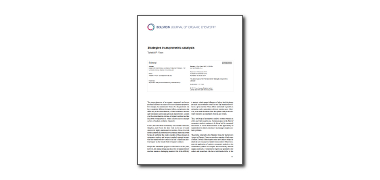Search results
Search for "curcumins" in Full Text gives 3 result(s) in Beilstein Journal of Organic Chemistry.
Correction: Diastereoselective synthesis of highly substituted cyclohexanones and tetrahydrochromene-4-ones via conjugate addition of curcumins to arylidenemalonates
Beilstein J. Org. Chem. 2025, 21, 1170–1170, doi:10.3762/bjoc.21.93

- Deepa Nair Abhishek Tiwari Banamali Laha Lakshminarayana Satham Irishi N. N. Namboothiri Department of Chemistry, Indian Institute of Technology Bombay, Mumbai, 400 076, India 10.3762/bjoc.21.93 Keywords: arylidenemalonates; curcumins; cyclohexanones; diastereoselective synthesis; Michael
Diastereoselective synthesis of highly substituted cyclohexanones and tetrahydrochromene-4-ones via conjugate addition of curcumins to arylidenemalonates
Beilstein J. Org. Chem. 2024, 20, 2016–2023, doi:10.3762/bjoc.20.177
- from curcumins and arylidenemalonates is reported. This strategy works in the presence of aqueous KOH using TBAB as a suitable phase transfer catalyst at room temperature. The functionalized cyclohexanones are formed as major products in moderate to excellent yields with complete diastereoselectivity
- in most cases. A triple Michael adduct, tetrahydrochromen-4-one, is also formed as a side product in a few cases with excellent diastereoselectivity. Keywords: arylidenemalonates; curcumins; cyclohexanones; diastereoselective synthesis; Michael reaction; tetrahydrochromenones; Introduction There is
- addition–cyclization of curcumins with chalcones to synthesize functionalized cyclohexanones have been reported [28][29]. On the other hand, diastereoselective cascade Michael addition–cyclization of curcumins with α-bromonitroalkenes and α-halodicyclopentadienones afforded functionalized dihyrofurans [26
Curcuminoid–BF2 complexes: Synthesis, fluorescence and optimization of BF2 group cleavage
Beilstein J. Org. Chem. 2017, 13, 2264–2272, doi:10.3762/bjoc.13.223
- release the curcuminoids as an alternative synthetic route to substituted curcumins. Results and Discussion Synthesis BF2 complexes First, we prepared the aldehydes 1a–h as the starting materials by Williamson ether synthesis of the corresponding hydroxybenzaldehydes with either propargyl bromide in dry





















